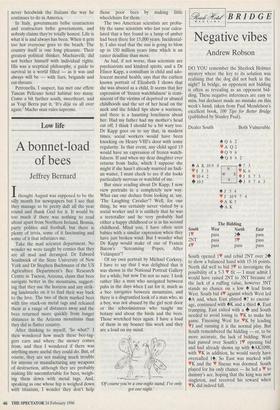Low life
A bonnet-load of bees
Jeffrey Bernard
Ithought August was supposed to be the silly month for newspapers but I see that they manage to be pretty daft all the year round and thank God for it. It would be too much if there was nothing to read about apart from Northern Ireland, Bosnia, party politics and football, but there is plenty of trivia, some of it fascinating and some of it that infuriates me.
Take the mad scientist department. No wonder we were taught by comics that they are all mad and deranged. Dr Edward Southwick of the State University of New York and Dr Stephen Buchmann of the US Agriculture Department's Bee Research Centre in Tucson, Arizona, claim that bees navigate better in the mountains, suggest- ing that they use the horizon and any strik- ing landmarks on it to find their way back to the hive. The two of them marked bees with tiny stuck-on metal tags and released them at a range of distances away and the bees returned more quickly from longer distances in the Arizona mountains than they did in flatter country.
After thinking to myself, 'So what?' I then wondered how much these bee-tag- gers earn and where the money comes from, and then I wondered if there was anything more useful they could do. But, of course, they are not making much trouble for anyone or manufacturing any weapons of destruction, although they are probably making life uncomfortable for bees, weigh- ing them down with metal tags. And, speaking as one whose hip is weighed down with titanium, I wonder they don't help those poor bees by making little wheelchairs for them.
The two American scientists are proba- bly the same scientists who last year calcu- lated that a bee found in a lump of amber had been there for 15,000 years. Incidental- ly, I also read that the sun is going to blow up in 150 million years time which is an easier deadline than most.
As bad, if not worse, than scientists are psychiatrists and kindred spirits, and a Dr Elinor Kapp, a consultant in child and ado- lescent mental health, says that the earliest known portrait of Elizabeth I shows that she was abused as a child, It seems that her expression of 'frozen watchfulness' is remi- niscent of the victims of deprived or abused childhoods and the set of her head on the neck and the folded lips show a wariness, and there is a haunting loneliness about her. Had my father had my mother's head cut off, I think I should be a bit wary too. Dr Kapp goes on to say that, in modern times, social workers would have been knocking on Henry VIII's door with some regularity. In that event, any child aged 13 would have an expression of frozen watch- fulness. If and when my dear daughter ever returns from India, which I suppose she might if she hasn't already married an Indi- an waiter, I must check to see if she looks particularly nervous or watchful of me.
But since reading about Dr Kapp, I now view portraits in a completely new way. What can one deduce from looking at, say, `The Laughing Cavalier'? Well, for one thing, he was certainly never visited by a social worker and it is unlikely that he was a teetotaller and he very probably had either a happy childhood or is in his second childhood. Mind you, I have often seen babies with a similar expression when they have just broken wind. But I wonder what Dr Kapp would make of one of Francis Bacon's 'Screaming Popes, After Velazquez'?
Of my own portrait by Michael Corkrey, I have to say that I was delighted that it was shown in the National Portrait Gallery for a while, but now I'm not so sure. I look rather like a man who navigated between pubs in the days when I sat for it, much as a bee navigates between mountains, and there is a disgruntled look of a man who, as a boy, was not abused by the girl next door or the schoolmistress who taught me botany and about the birds and the bees. Those wretched bees again. I have a load of them in my bonnet this week and they are a load on my mind.
`Of course you're a one-night stand, I've only got one night.'


























































 Previous page
Previous page